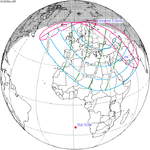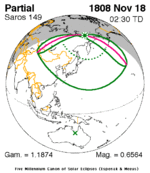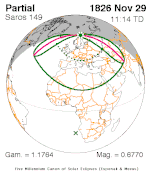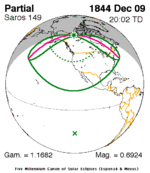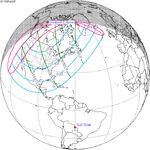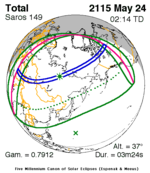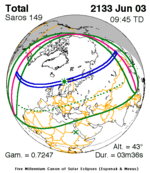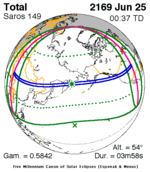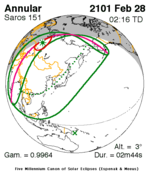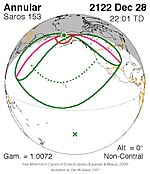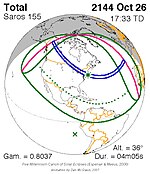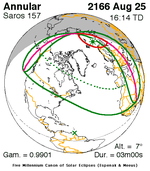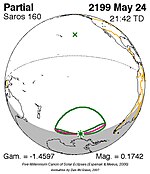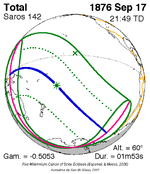| Total eclipse | |
| Gamma | 0.9081 |
|---|---|
| Magnitude | 1.0512 |
| Maximum eclipse | |
| Duration | 175 s (2 min 55 s) |
| Coordinates | 66°12′N46°18′W / 66.2°N 46.3°W |
| Max. width of band | 406 km (252 mi) |
| Times (UTC) | |
| Greatest eclipse | 10:50:13 |
| References | |
| Saros | 149 (24 of 71) |
| Catalog # (SE5000) | 9685 |
A total solar eclipse will occur at the Moon's ascending node of orbit on Monday, May 1, 2079, [1] with a magnitude of 1.0512. A solar eclipse occurs when the Moon passes between Earth and the Sun, thereby totally or partly obscuring the image of the Sun for a viewer on Earth. A total solar eclipse occurs when the Moon's apparent diameter is larger than the Sun's, blocking all direct sunlight, turning day into darkness. Totality occurs in a narrow path across Earth's surface, with the partial solar eclipse visible over a surrounding region thousands of kilometres wide. Occurring about 1.2 days before perigee (on May 2, 2079, at 14:45 UTC), the Moon's apparent diameter will be larger. [2]
Contents
- Visible cities
- Eclipse details
- Eclipse season
- Related eclipses
- Eclipses in 2079
- Metonic
- Tzolkinex
- Half-Saros
- Tritos
- Solar Saros 149
- Inex
- Triad
- Solar eclipses of 2076–2079
- Saros 149
- Metonic series
- Tritos series
- Inex series
- Notes
- References
The path of totality will be visible from parts of Maryland, Delaware, Pennsylvania, New Jersey, New York, Connecticut, Massachusetts, Rhode Island, Vermont, New Hampshire, and Maine in the United States, eastern Canada (including Newfoundland and Labrador, New Brunswick, Nova Scotia and Prince Edward Island), and Greenland. A partial solar eclipse will also be visible for parts of eastern North America, the eastern Caribbean, Northwest Africa, Europe, and much of Russia.
This will be the first total eclipse visible from New York City since January 24, 1925, and unlike the previous eclipse, the city will experience totality across the entire city limits.



